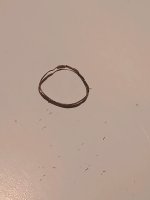I was working up a load with a new powder (Sta-Ball) for a 7-08 with some old lot 120 Sierras, made in California, and after 15 shots I cleaned to switch powders, and on the first patch, this came out. Shot these bullets with other powders and no problems. I called and emailed Sierra and they told me that no one there has ever seen this happen. Anyone ever seen anything like this before?


Last edited:

